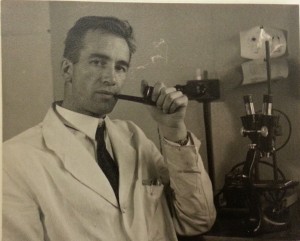 Being lucky, as I am, to work with a wide variety of archival collections relating to the history of animal genetics in Edinburgh, it can be mightily difficult to select an all-time ‘favourite’ item. However, it was ‘make-up-your-mind time’ last month at the University of Edinburgh’s Innovative Learning Week, when myself and several colleagues from the Centre for Research Collections were invited to give a Pecha Kucha (a fast-paced and time-controlled) presentation on our favourite items or aspects of the collections with which we work.
Being lucky, as I am, to work with a wide variety of archival collections relating to the history of animal genetics in Edinburgh, it can be mightily difficult to select an all-time ‘favourite’ item. However, it was ‘make-up-your-mind time’ last month at the University of Edinburgh’s Innovative Learning Week, when myself and several colleagues from the Centre for Research Collections were invited to give a Pecha Kucha (a fast-paced and time-controlled) presentation on our favourite items or aspects of the collections with which we work.
For me, there were a few strong contenders, but the ultimate winner had to be a photograph album presented to C.H. Waddington, the director of the Institute of Animal Genetics in Edinburgh, by his staff and students on the occasion of his 50th birthday in 1955.
The beautifully presented volume is still in perfect condition and contains a wonderful selection of photographs, all with careful names and annotations. The more formal portraits of staff and scientific researchers give a unique insight into laboratory and research work in the 1950s. In terms of white coats and microscopes, not much has changed today, but I’m not so sure about this suave example of pipe-smoking!
The album also contains pictures of individuals who don’t always feature in the official histories of Edinburgh’s animal genetics community, including the scientists’ wives. The Institute was sometimes rumoured to be a hotbed of scandal and intrigue, so one would like to have been a fly on the wall at this particular party…
I also love the informal and humorous photographs in the album, which paint a much more individual and human picture of the geneticists’ lives and working environment than can be gained simply through printed papers, research reports and official correspondence. Who can fail to be inspired by pictures of an amateur ballet based on the fruit fly Drosophila, for example?
You can watch a video of the Pecha Kucha here: http://vimeo.com/87273640





It is fun to see some of the people I knew at the Institute, 12 years before I got there to do my postdoctoral work in 1967. Someone once described the building as “a perfectly preserved British science institute of the 1920s”. The person at the Institute most relevant to Dolly was surely Anne McLaren, who pioneered ovum transplantation, working in mice.
Dear Professor Felsenstein,
Many thanks indeed for your message, and I am pleased you enjoyed seeing the photographs. That is a lovely (and, I think, pretty accurate) description of the Institute building, which still stands today – although it is now home to the School of GeoSciences. Anne McLaren was indeed a hugely important figure, as you say. We did write a blog post about her as well which you may like to take a look at: http://libraryblogs.is.ed.ac.uk/towardsdolly/2014/10/16/dame-anne-mclaren-1927-2007/
All the best and thanks again for your comment,
Clare (Project Archivist)
could it not be Charlotte Auerbach, 2nd from right in “wives” photo?
Hi Robin, It is indeed Lotte Auerbach. The other women (with the exception of the unidentified lady with her back to the camera) are Beatrice Kacser, Justin Waddington and Margaret Falconer, who were all married to scientists at the Institute.